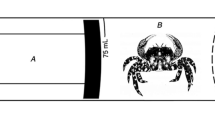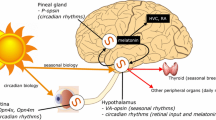Summary
The timing of bouts of torpor was continuously monitored in 36 pocket mice,Perognathus longimembris, for as long as 11 months. Animals were kept at 8 °C or 18 °C, with light cycles of LD 12∶12, 10∶14, 15∶9, or continuous darkness. At 8 °C, torpor duration had a polymodal frequency distribution, and the near absence of bouts of torpor lasting exactly 24, 48, 72, and 96 h divided the bouts into discrete classes (one-day, two-day, etc.). The maximum duration of torpor was 2.5 times greater at 8 °C than 18 °C.
A circadian rhythmicity in the timing of all classes of torpor bouts was indicated because, when entrained to a 24-h photocycle, the intervals between successive arousals were multiples of 24 h. This rhythmicity persisted in continuous darkness, demonstrating its endogenous origin.
There were two different free-running periods (τ) for the torpor rhythm of each animal in constant darkness at 8 °C. In general, series of multi-day torpor bouts had a period less than 24 h, while series of one-day bouts showed a period near to or greater than 24 h. The transition between the two frequencies of the torpor rhythm commonly coincided with a phase shift involving one or more transient cycles.
The general circadian oscillator model of Aschoff and Wever was modified to describe the timing and the changes in duration of torpor. The data may be viewed as arising from an asymmetrical oscillation which is synchronized by the lights-on transition of the photocycle, and whose shape is correlated with the period of the rhythm. The different classes of torpor (one-day, two-day, etc.) were also timed differently with respect to the entraining conditions of a light-dark cycle, and these differences in timing are consistent with oscillator theory.
Similar content being viewed by others
References
Aschoff, J., Diehl, I., Gerecke, U., Wever, R.: Aktivitäts-Periodik von Buchfinken (Fringilla coelebs L.) unter konstanten Bedingungen. Z. vergl. Physiol.45, 605–617 (1962)
Aschoff, J., Gerecke, U., Kureck, A., Pohl, H., Rieger, P., Saint Paul, U. v., Wever, R.: Interdependent parameters of circadian activity rhythms in birds and man. In: Biochronometry (ed. M. Menaker), pp. 3–29. Washington D.C.: National Academy of Sciences 1971
Aschoff, J., Wever, R.: Über Phasenbeziehungen zwischen biologischer Tagesperiodik und Zeitgeberperiodik. Z. vergl. Physiol.46, 115–128 (1962)
Bartholomew, G.A., Cade, T.J.: Temperature regulation and aestivation in the little pocket mousePerognathus longimembris. J. Mammal.38, 60–72 (1957)
Baumer, J., South, F.E., Ferren, L., Zataman, M.L.: A possible basis for periodic arousals during hibernation: accumulation of ketone bodies. Life Sci.10, 463–471 (1971)
Brower, J.E., Cade, T.J.: Bicircadian torpor in pocket mice. Bioscience21, 181–182 (1971)
Brown, J.H., Bartholomew, G.A.: Periodicity and energetics of torpor in the kangaroo mouse,Microdipodops pallidus. Ecology50, 705–709 (1969)
Bünning, E.: The physiological clock. Berlin-Heidelberg-New York: Springer 1973
Chew, R.M., Butterworth, B.B.: Ecology of rodents in Indian Cove (Mojave Desert), Joshua Tree National Monument, California. J. Mammal.45, 203–225 (1964)
Chew, R.M., Lindberg, R.G., Hayden, P.: Circadian rhythm of metabolic rate in pocket mice. J. Mammal.46, 477–494 (1965)
Daan, S.: Periodicity of heterothermy in the garden dormouse,Eliomys quercinus (L). Neth. J. Zool.23, 237–265 (1973)
DeCoursey, G., DeCoursey, P.J.: Adaptive aspects of activity rhythms in bats. Biol. Bull.126, 14–27 (1964)
Eskin, A.: Some properties of the system controlling the circadian activity rhythm of sparrows. In: Biochronometry (ed. M. Menaker), pp. 55–80. Washington D.C.: National Academy of Sciences 1971
Fisher, K.C.: On the mechanism of periodic arousal in the hibernating ground squirrel. Ann. Acad. Sci. fenn. Ser. A IV71, 143–156 (1964)
Fisher, K.C., Manery, J.F.: Water and electrolyte metabolism in heterotherms. In: Mammalian hibernation III (eds. K.C. Fisher et al.), pp. 235–279. Edinburgh: Oliver and Boyd 1967
Fisher, K.C., Mrosovsky, N.: Effectiveness of KCl and NaCl injections in arousing 13-lined ground squirrels from hibernation. Canad. J. Zool.48, 595–596 (1970)
French, A.R.: The timing and energetics of hibernation in the little pocket mouse,Perognathus longimembris. Ph.D. Thesis. Univ. of Calif., Los Angeles. 104 p. (1975)
Galster, W.A., Morrison, P.: Cyclic changes in carbohydrate concentrations during hibernation in the arctic ground squirrel. Amer. J. Physiol.218, 1228–1232 (1970)
Gębczyński, M., Gorecki, A., Drozdz, A.: Metabolism, food assimilation, and bioenergetics of three species of dormice (Gliridae). Acta theriol.21, 271–294 (1972)
Grinnell, J., Swarth, H.S.: An account of the birds and mammals of the San Jacinto area of Southern California. U.C. Publ. Zool.10, 197–406 (1913)
Hamner, K.C., Hoshizaki, T.: Photoperiodism and circadian rhythms: a hypothesis. Bioscience24, 407–414 (1974)
Hoffmann, K.: Versuche zur Analyse der Tagesperiodik. Z. vergl. Physiol.43, 544–566 (1960)
Hudson, J.W.: Variation in patterns of torpidity of small homeotherms. In: Mammalian hibernation III (eds. K.C. Fisher et al.), pp. 30–46. Edinburgh: Oliver and Boyd 1967
Johansen, K., Krog, J.: Diurnal body temperature variations and hibernation in the birchmouse,Sicista betulina. Amer. J. Physiol.196, 1200–1204 (1959)
Kenagy, G.J.: Daily and seasonal patterns of activity and energetics in a heteromyid rodent community. Ecology54, 1201–1219 (1973)
Lindberg, R.G., Gambino, J.J., Hayden, P.: Circadian periodicity of resistance to ionizing radiation in the pocket mouse. In: Biochronometry (ed. M. Menaker), pp. 169–185. Washington D.C.: National Academy of Sciences 1971
Lindberg, R.G., Hayden, P.: Research on the properties of circadian systems amenable to study in space. Northrop Research Laboratory Report 1974
Menaker, M.: The free-running period of the bat clock. Seasonal variations at low body temperatures. J. cell. comp. Physiol.57, 81–86 (1961)
Pengelley, E.T., Asmundson, S., Uhlman, C.: Homeostasis during hibernation in the golden-mantled ground squirrelCitellus lateralis. Comp. Biochem. Physiol.38A, 645–653 (1971)
Pengelley, E.T., Fisher, K.C.: Rhythmical arousal from hibernation in the golden-mantled ground squirrel,Citellus lateralis tescorum. Canad. J. Zool.39, 105–120 (1961)
Pittendrigh, C.S.: Circadian rhythms and circadian organization of living systems. Cold Spr. Harb. Symp. quant. Biol.25, 159–182 (1960)
Pittendrigh, C.S.: Circadian rhythms, space research and manned space flight. In: Life sciences and space research (eds. A.H. Brown, F.G. Favorite), pp. 122–134. Amsterdam: North-Holland Publ. Co. 1967
Pittendrigh, C.S.: Circadian oscillations in cells and the circadian organization of multicellular systems. In: The neurosciences third study program (F.O. Schmitt, F.G. Worden, eds.), pp. 437–458. Cambridge, Mass.: The MIT Press 1974
Pohl, H.: Temperaturregulation und Tagesperiodik des Stoffwechsels bei Winterschläfern. Z. vergl. Physiol.45, 109–153 (1961)
Prewitt, R.L., Anderson, G.L., Musacchia, X.J.: Evidence for a metabolic limitation of survival in hypothermic hamsters. Proc. Soc. exp. Biol. (N.Y.)140, 1279–1283 (1972)
Rawson, K.C.: Effects of tissue temperature on mammalian activity rhythms. Cold Spr. Harb. Symp. quant. Biol.25, 105–113 (1960)
Skopik, S.D., Pittendrigh, C.S.: Circadian systems, II. The oscillation in the individualDrosophila pupa; its independence of developmental stage. Proc. nat. Acad. Sci. (Wash.)58, 1862–1869 (1967)
Strumwasser, F., Schlechte, F.R., Streeter, J.: The internal rhythms of hibernators. In: Mammalian hibernation III (eds. K.C. Fisher et al.), pp. 110–139. Edinburgh: Oliver and Boyd 1967
Swade, R.H., Pittendrigh, C.S.: Circadian locomotor rhythms of rodents in the arctic. Amer. Nat.101, 431–466 (1967)
Tucker, V.A.: Diurnal torpor and its relation to food consumption and weight changes in the California pocket mouse,Perognathus californicus. Ecology47, 245–252 (1966)
Twente, J.W., Twente, J.A.: Effects of core temperature upon the duration of hibernation ofCitellus lateralis. J. appl. Physiol.20, 411–416 (1965)
Twente, J.W., Twente, J.A.: Effects of epinephrine upon the progressive irritability of hibernatingCitellus lateralis. Comp. Biochem. Physiol.25, 475–483 (1968)
Wever, R.: A mathematical model for circadian rhythms. In: Circadian clocks (ed. J. Aschoff), pp. 47–63. Amsterdam: North-Holland Publ. Co. 1965
Wever, R.: Gesetzmäßigkeiten der circadianen Periodik des Menschen, geprüft an der Wirkung eines schwachen elektrischen Wechselfeldes. Pflügers Arch.302, 97–122 (1968)
Willis, J.F., Goldman, S., Foster, S.: Tissue K-concentration in relation to the role of the kidney in hibernation and the cause of periodic arousal. Comp. Biochem. Physiol.39A, 437–445 (1971)
Author information
Authors and Affiliations
Additional information
This study was conducted while the author was in receipt of a U.S. Atomic Energy Commission fellowship. Instrumentation and logistic support were provided by National Science Foundation grant #GB32947 to G.A. Bartholomew. I wish to thank George A. Bartholomew for suggestions throughout the course of this study, and also James Enright, Karl Hamner, and G.J. Kenagy for numerous helpful suggestions.
Rights and permissions
About this article
Cite this article
French, A.R. Periodicity of recurrent hypothermia during hibernation in the pocket mouse,Perognathus longimembris . J. Comp. Physiol. 115, 87–100 (1977). https://doi.org/10.1007/BF00667787
Received:
Issue Date:
DOI: https://doi.org/10.1007/BF00667787




